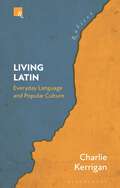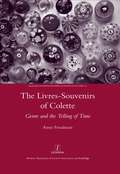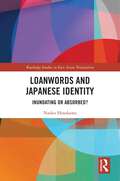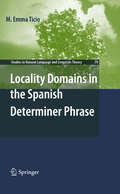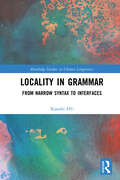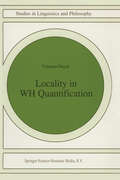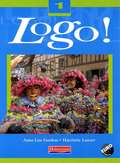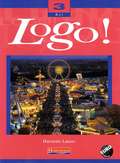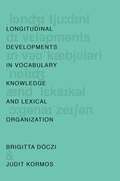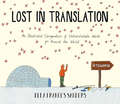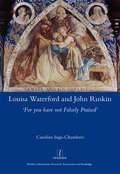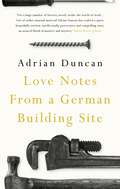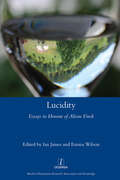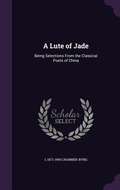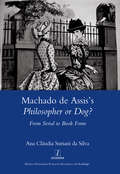- Table View
- List View
Living Latin: Everyday Language and Popular Culture (Rubicon)
by Dr Charlie KerriganWhat kind of language is Latin, and who is it for? Contrary to most accounts, this book tells the story of Latin as a language of ordinary people. Surveying the whole span of the language's history, it explores the evidence that exists for ordinary Latin around the Roman world, arguing that this material is just as worthy of readers' attention as the famous classics. Those classics are reassessed in the light of popular concerns, as works of art that evoke ancient, sustainable, and communal ways of living, encompassing broad and diverse traditions of readers through time. And of course Latin lived on: this account revisits what happened to the language after the Roman empire, tracing its twin streams - intellectual lingua franca and a series of Romance languages - into the twenty-first century. What emerges is a human chain stretching back thousands of years and still in existence today, a story of workers and weavers, violets and roses, storytellers and musicians, a common and democratic archive of world history. Kerrigan's strong and attractive case for a new conception of Latin sends out a call to arms to reevaluate the place of Latin in history. On the one hand, an interesting and readable history of the language, on the other, this book sets out to provoke questions for readers, students, and teachers of Latin, as well as anyone interested in the ancient Mediterranean world. Latin was and should always be for all.
Living Latin: Everyday Language and Popular Culture (Rubicon)
by Dr Charlie KerriganWhat kind of language is Latin, and who is it for? Contrary to most accounts, this book tells the story of Latin as a language of ordinary people. Surveying the whole span of the language's history, it explores the evidence that exists for ordinary Latin around the Roman world, arguing that this material is just as worthy of readers' attention as the famous classics. Those classics are reassessed in the light of popular concerns, as works of art that evoke ancient, sustainable, and communal ways of living, encompassing broad and diverse traditions of readers through time. And of course Latin lived on: this account revisits what happened to the language after the Roman empire, tracing its twin streams - intellectual lingua franca and a series of Romance languages - into the twenty-first century. What emerges is a human chain stretching back thousands of years and still in existence today, a story of workers and weavers, violets and roses, storytellers and musicians, a common and democratic archive of world history. Kerrigan's strong and attractive case for a new conception of Latin sends out a call to arms to reevaluate the place of Latin in history. On the one hand, an interesting and readable history of the language, on the other, this book sets out to provoke questions for readers, students, and teachers of Latin, as well as anyone interested in the ancient Mediterranean world. Latin was and should always be for all.
The Livres-souvenirs of Colette: Genre and the Telling of Time
by Anne FreadmanThroughout her career, Colette experimented with genre for the purposes of telling stories of her life. The books that resulted, known collectively as her 'livres-souvenirs', are far from being autobiographies in the customary sense. By addressing the need to reconsider the generic issues surrounding autobiographical story-telling, Anne Freadman's study brings the richness of 'the genre question' to the fore, shedding a fresh light on this much-loved body of work. From the vignettes ofLa Maison de Claudineto the note-books ofL'etoile vesper andLe Fanal bleu, from stories of losing to stories of collecting, Colette's memory books take different narrative forms and explore the passing of time in different ways. This book investigates Colette's variegated generic choices as so many ways of 'telling time'.
The Livres-souvenirs of Colette: Genre and the Telling of Time
by Anne FreadmanThroughout her career, Colette experimented with genre for the purposes of telling stories of her life. The books that resulted, known collectively as her 'livres-souvenirs', are far from being autobiographies in the customary sense. By addressing the need to reconsider the generic issues surrounding autobiographical story-telling, Anne Freadman's study brings the richness of 'the genre question' to the fore, shedding a fresh light on this much-loved body of work. From the vignettes ofLa Maison de Claudineto the note-books ofL'etoile vesper andLe Fanal bleu, from stories of losing to stories of collecting, Colette's memory books take different narrative forms and explore the passing of time in different ways. This book investigates Colette's variegated generic choices as so many ways of 'telling time'.
Loanwords and Japanese Identity: Inundating or Absorbed? (Routledge Studies In East Asian Translation Ser.)
by Naoko HosokawaLoanwords and Japanese Identity: Inundating or Absorbed? provides an in-depth examination of public discussions on lexical borrowing in the Japanese language. The main objective of this book is to explore the relationship between language and identity through an analysis of public attitudes towards foreign loanwords in contemporary Japanese society. In particular, the book uncovers the process by which language is conceived of as a symbol of national identity by examining an animated newspaper controversy over the use of foreign loanwords. The book concludes that the fierce debate over the use of loanwords can be understood as a particular manifestation of the ongoing (re-)negotiation of Japanese national identity. This book will appeal to scholars and students in sociolinguistics, translation studies, and discourse analysis, while its cultural and geographic focus will attract readers in Japanese studies and East Asian studies.
Loanwords and Japanese Identity: Inundating or Absorbed? (Routledge Studies In East Asian Translation Ser.)
by Naoko HosokawaLoanwords and Japanese Identity: Inundating or Absorbed? provides an in-depth examination of public discussions on lexical borrowing in the Japanese language. The main objective of this book is to explore the relationship between language and identity through an analysis of public attitudes towards foreign loanwords in contemporary Japanese society. In particular, the book uncovers the process by which language is conceived of as a symbol of national identity by examining an animated newspaper controversy over the use of foreign loanwords. The book concludes that the fierce debate over the use of loanwords can be understood as a particular manifestation of the ongoing (re-)negotiation of Japanese national identity. This book will appeal to scholars and students in sociolinguistics, translation studies, and discourse analysis, while its cultural and geographic focus will attract readers in Japanese studies and East Asian studies.
El lobo, el bosque y el hombre nuevo
by Senel Paz[Wikipedia] Senel Paz (born 1950) is a Cuban author and screenwriter. He was born in Fomento, Sancti Spíritus. He is best known for his short story The Wolf, the Forest and the New Man, for which he was awarded the Juan Rulfo Prize and which he subsequently adapted into the screenplay for Tomas Gutierrez Alea's celebrated movie Strawberry and Chocolate (1994).
Locality Domains in the Spanish Determiner Phrase (Studies in Natural Language and Linguistic Theory #79)
by M. Emma TicioExamining its subject from a generative perspective, this highly detailed text deals with the syntax of nominal expressions. It focuses on empirical data taken from the Spanish language, though the author goes further to draw conclusions of wider theoretical interest from material culled from other languages too. The book considers crucial phenomena in the nominal domain, such as extraction out of nominal phrases and ellipsis in these phrases, as well as their modification. In doing so it provides the reader with a unified explanation of a number of phenomena that have not previously been analyzed under a single basic account. In particular, Ticio explores how economy notions interact with a number of functional categories, with the length and type of movements allowed, and with the existence of three internal domains within nominal expressions. She uses these observations to inform her analysis of the structure of arguments and adjuncts in nominal expressions, and of the potential these elements have for extraction. To test the empirical adequacy of her analysis, she employs phenomena such as the properties of attributive adjectives, partial cliticization and nominal elision in Spanish nominal phrases.
Locality in Grammar: From Narrow Syntax to Interfaces (Routledge Studies in Chinese Linguistics)
by Xiaoshi HuLocality in Grammar: From Narrow Syntax to Interfaces investigates the operation of locality conditions in syntax and semantics from a cross-linguistic perspective.It is claimed that there are two different types of locality conditions. One is the Generalized Minimality Condition (GMC), and the other is the Phase Impenetrability Condition (PIC). This book demonstrates that these locality conditions play different roles in different computational components of human language, and, therefore, cannot be unified as one constraint as proposed in the literature.The main idea of the book is that the two different locality conditions are sensitive to the difference between syntactic derivation and semantic interpretation and that of overt and covert syntactic derivations. Further investigation shows a more fine-grained distinction must be made between syntactic computations. It is true that GMC does not constrain overt syntactic derivations and PIC does not play a role in semantic interpretations; however, they both regulate covert syntactic computations.This book will inform postgraduate students and scholars in the field of linguistics.
Locality in Grammar: From Narrow Syntax to Interfaces (Routledge Studies in Chinese Linguistics)
by Xiaoshi HuLocality in Grammar: From Narrow Syntax to Interfaces investigates the operation of locality conditions in syntax and semantics from a cross-linguistic perspective.It is claimed that there are two different types of locality conditions. One is the Generalized Minimality Condition (GMC), and the other is the Phase Impenetrability Condition (PIC). This book demonstrates that these locality conditions play different roles in different computational components of human language, and, therefore, cannot be unified as one constraint as proposed in the literature.The main idea of the book is that the two different locality conditions are sensitive to the difference between syntactic derivation and semantic interpretation and that of overt and covert syntactic derivations. Further investigation shows a more fine-grained distinction must be made between syntactic computations. It is true that GMC does not constrain overt syntactic derivations and PIC does not play a role in semantic interpretations; however, they both regulate covert syntactic computations.This book will inform postgraduate students and scholars in the field of linguistics.
Locality in WH Quantification: Questions and Relative Clauses in Hindi (Studies in Linguistics and Philosophy #62)
by Veneeta DayalLocality in WH Quantification argues that Logical Form, the level that mediates between syntax and semantics, is derived from S-structure by strictly local movement. The primary data for the claim of locality at LF is drawn from Hindi but English data is used in discussing the semantics of questions and relative clauses. The book takes a cross-linguistic perspective showing how the Hindi and English facts can be brought to bear on the theory of universal grammar. There are several phenomena generally thought to involve long-distance dependencies at LF, such as scope marking, long-distance list answers and correlatives. In this book they are handled by explicating novel types of local relationships that interrogative and relative clauses can enter. Amore articulated semantics is shown leading to a simpler syntax. Among other issues addressed is the switch from uniqueness/maximality effects in single WH constructions to list readings in multiple WH constructions. These effects are captured by adapting the treatment of WH expressions as quantifying over functions to the cases of multiple WH questions and correlatives. List readings due to functional dependencies are systematically distinguished from those that are based on plurality.
Logo! 1
by Anna Lise Gordon Harriette LanzerThe ideal resource for teaching German. Logo! Is a lively new German course which has a topic based approach combined with clear grammatical progression. Offering plenty of enjoyable and motivating activities Logo! caters for a wide ability range at Key Stages 3 and 4. Fully differentiated at each level. Lively communicative approach. Integrated grammar explanations and practice. Opportunities for assessment throughout including end-of-chapter tests. Independent reading and writing section. Key language learning skills highlighted. Comprehensive vocabulary lists. Stage 1 covers levels 1-4 of the National Curriculum and is also fully cross-referenced to the Scottish 5-14 Guidelines.
Logo! 1
by Anna Lise Gordon Harriette LanzerThe ideal resource for teaching German. Logo! Is a lively new German course which has a topic based approach combined with clear grammatical progression. Offering plenty of enjoyable and motivating activities Logo! caters for a wide ability range at Key Stages 3 and 4. Fully differentiated at each level. Lively communicative approach. Integrated grammar explanations and practice. Opportunities for assessment throughout including end-of-chapter tests. Independent reading and writing section. Key language learning skills highlighted. Comprehensive vocabulary lists. Stage 1 covers levels 1-4 of the National Curriculum and is also fully cross-referenced to the Scottish 5-14 Guidelines.
Logo! 3 Rot: Pupil Book (1st edition)
by Harriette LanzerEverything you hoped to see in a German course! Published in direct response to teachers' comments and suggestions, Logo! has been shown to really work in the classroom from age 11 right through to 16.
Logo! 3 Rot Pupil Book
by Harriette LanzerEverything you hoped to see in a German course! Published in direct response to teachers' comments and suggestions, Logo! has been shown to really work in the classroom from age 11 right through to 16.
Logo! 3 Rot Pupil Book (PDF)
by Harriette LanzerEverything you hoped to see in a German course! Published in direct response to teachers' comments and suggestions, Logo! has been shown to really work in the classroom from age 11 right through to 16.
Longitudinal Developments in Vocabulary Knowledge and Lexical Organization
by Brigitta Dóczi Judit KormosWords are the building blocks of human communication and provide a strong foundation for the development of skilled language production and comprehension. Learning words in a language other than one's own requires long-term commitment and substantial engagement. This research monograph offers a summary of how learners of additional languages acquire vocabulary in instructed foreign language contexts and in English for Academic Purposes programs in the target language environment. After a thorough introduction of the most important constructs in the first chapter, the book provides a comprehensive description of the processes of longitudinal development in learners' growth of vocabulary size and depth of word knowledge. In the second half, the authors make novel connections between the fields of second language acquisition and vocabulary research. They then show how individual differences between learners can influence the processes and outcomes of vocabulary learning. The book concludes with evidence-based practical guidance to language teachers on how to enhance their students' lexical knowledge.
Lost in Translation: An Illustrated Compendium of Untranslatable Words
by Ella Frances SandersDid you know that the Japanese have a word to express the way sunlight filters through the leaves of trees? Or, that there’s a Swedish word that means a traveller’s particular sense of anticipation before a trip? Lost in Translation, a New York Times bestseller, brings the nuanced beauty of language to life with over 50 beautiful ink illustrations. The words and definitions range from the lovely, such as goya, the Urdu word to describe the transporting suspension of belief that can occur in good storytelling, to the funny, like the Malay word pisanzapra, which translates as 'the time needed to eat a banana' .This is a collection full of surprises that will make you savour the wonderful, elusive, untranslatable words that make up a language.
Louisa Waterford and John Ruskin: 'For You Have Not Falsely Praised'
by Caroline Ings-ChambersLouisa Waterford (1818-91), modest, retiring, of good family, renowned for her beauty, and with extraordinary grace, was the embodiment of a Victorian ideal of womanhood. But like the age itself, her life was filled with contrasts and paradoxes. She had been born with artistic gifts, and became a satellite of the Pre-Raphaelite Brotherhood, though she had no formal training. Then, at the height of John Ruskin's intellectual power and success as a critic, she asked him to accept her as an art student, and he accepted. Their correspondence- often harshly critical, never, as Waterford put it, falsely praising - lies at the heart of this book. These are letters which open a spectrum of discussion on the cultural, gender and social issues of the period. Both Waterford and Ruskin engaged in tireless philanthropic work for diverse causes, crossing social boundaries with subtle determination, and both responded to a sense of duty as well as an artistic vocation. But, as Ings-Chambers shows, their correspondence was more than a dialogue about society: it helped to make Waterford the artist she became.
Louisa Waterford and John Ruskin: 'For You Have Not Falsely Praised'
by Caroline Ings-ChambersLouisa Waterford (1818-91), modest, retiring, of good family, renowned for her beauty, and with extraordinary grace, was the embodiment of a Victorian ideal of womanhood. But like the age itself, her life was filled with contrasts and paradoxes. She had been born with artistic gifts, and became a satellite of the Pre-Raphaelite Brotherhood, though she had no formal training. Then, at the height of John Ruskin's intellectual power and success as a critic, she asked him to accept her as an art student, and he accepted. Their correspondence- often harshly critical, never, as Waterford put it, falsely praising - lies at the heart of this book. These are letters which open a spectrum of discussion on the cultural, gender and social issues of the period. Both Waterford and Ruskin engaged in tireless philanthropic work for diverse causes, crossing social boundaries with subtle determination, and both responded to a sense of duty as well as an artistic vocation. But, as Ings-Chambers shows, their correspondence was more than a dialogue about society: it helped to make Waterford the artist she became.
Love Notes from a German Building Site
by Adrian DuncanPaul, a young Irish engineer, follows his girlfriend to Berlin and begins work on the renovation of a commercial building in Alexanderplatz. Wrestling with a new language, on a site running behind schedule, and with a relationship in flux, he becomes increasingly untethered. Set against the structural evolution of a sprawling city, this meditation on language, memory and yearning is underpinned by the site's physical reality. As the narration explores the mind's fragile architecture, he begins to map his own strange geography through a series of notebooks, or 'Love notes'. 'In such a brutish and masculine atmosphere, Duncan's account is an unmasked ray of hope... The prose is minimal, yet the ideas are maximal. If more men thought and wrote as tenderly and honestly as Adrian Duncan, we'd have stronger, sturdier novels and fewer garish monuments to consumerism' Irish Independent.
Lucidity: Essays in Honour of Alison Finch (Legenda)
by Ian James and Emma WilsonThis collection of essays addresses the question of lucidity as a thematic in literature and film but also as a quality of both expression and insight in literary criticism and critical thought more generally. The essays offer treatments of lucidity in itself and in relation to its opposites, forms of obscurity and darkness. They offer attention to problems of philosophical thought and reason, to questions of literary and poetic form, and of photographic and filmic contemplation. Ranging from engagements with early modern writing through to more recent material the contributions focus in particular on nineteenth- and twentieth-century French prose and poetry, the field which has been the predominant focus of Alison Finch’s critical writing. They are written as tributes to the distinctively lucid insights of her work and to the breadth and clarity of its intellectual engagement.
Lucidity: Essays in Honour of Alison Finch (Legenda)
by Ian James Emma WilsonThis collection of essays addresses the question of lucidity as a thematic in literature and film but also as a quality of both expression and insight in literary criticism and critical thought more generally. The essays offer treatments of lucidity in itself and in relation to its opposites, forms of obscurity and darkness. They offer attention to problems of philosophical thought and reason, to questions of literary and poetic form, and of photographic and filmic contemplation. Ranging from engagements with early modern writing through to more recent material the contributions focus in particular on nineteenth- and twentieth-century French prose and poetry, the field which has been the predominant focus of Alison Finch’s critical writing. They are written as tributes to the distinctively lucid insights of her work and to the breadth and clarity of its intellectual engagement.
Machado De Assis's Philosopher or Dog?: From Serial to Book Form
by Surianida SilvaThe great Brazilian writer Joaquim Maria Machado de Assis (1839-1908) published five of his nine novels as feuilletons in daily newspapers or fortnightly women's magazines. How were the structure and themes of those novels entangled with this serial-publication form? In da Silva's important new study, textual scholarship, critical theory and the history of the book are combined in order to trace this relationship. The most important case study is an extended consideration of Philosopher or Dog? (1891), the novel after which he abandoned the feuilleton. Through a comparison of the serial and book versions of Philosopher or Dog? and a thorough study of the periodical in which it appeared, the international women's magazine The Season , da Silva analyses the changes which the genre novel was undergoing at the end of the nineteenth century: the decline of the serial, and the standardisation of female press. Ana Claudia Suriani da Silva is Tutor of Portuguese at the University of Birmingham and Honorary Research Fellow at Birkbeck College, University of London.
